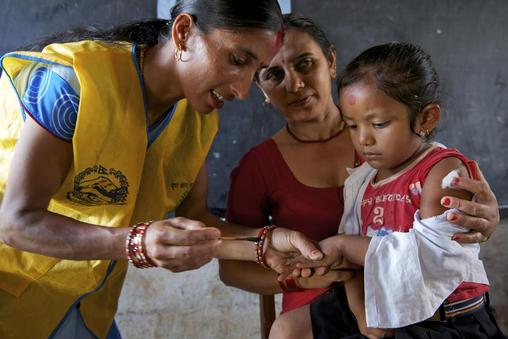Wiping Out Rubella Worldwide: A Leading Cause of Vaccine-Preventable Birth Defects

A community health volunteer inks a girl’s finger, indicating she has just been vaccinated, in Lamjung. Some 50,000 woman volunteers provide critical primary health services nationwide. Nepal’s largest-ever public health campaign is targeting some 10 million children with measles-rubella immunizations. Photo Credit: UNICEF
A disease that causes brain damage in an unborn baby may bring Zika to mind; however more than 50 years ago, such birth defects were usually the result of rubella, also known as German measles.
The rubella epidemic of the 1960s in the United States struck fear into the hearts of many mothers-to-be who were concerned that their babies could be harmed by the virus. A pregnant woman, as well as children and adults, may experience mild symptoms, such as a slight fever and light rash. But if the virus attacks an unborn child, he or she has up to a 90% chance of being born with congenital rubella syndrome (CRS), which results in multiple birth defects, such as brain damage, heart disease, and vision and hearing impairment.
During the epidemic, rubella caused stillbirths and more than 20,000 babies to born with CRS. This crisis drove the urgent need for researchers to develop the vaccine that in 2000 resulted in wiping out naturally occurring rubella in the United States.
However, there are many places around the world where rubella is still a very real threat. Each year, more than 100,000 babies are born with CRS, most in Southeast Asia, because their mothers do not have access to the safe and effective vaccine that prevents the ravages of CRS that last a lifetime. These birth defects also take a toll on the family and caregivers in terms of the emotional, social, and financial demands.
It only costs $2 to vaccinate a child against both measles and rubella in developing countries, and the payoff is huge in protecting vulnerable children from a dreaded disease. Every dollar invested in the vaccines yields a $58 return.
Unfortunately, rubella is still a leading cause of vaccine-preventable birth defects. But the Centers for Disease Control and Prevention (CDC) is working hard to change that—and has made a huge impact.
By working with like-minded organizations to increase the number of people and countries vaccinating against rubella, the global tide is turning against the disease.
The latest data shows more countries are providing the vaccine. From 2000 to 2016, 53 countries introduced the rubella vaccine, for a total of 152 out of 194-countries.
With more countries protecting more people with the vaccine, the estimated number of rubella cases has dropped from 670,894 in 2000 to 22,361 in 2016.
The striking decrease in rubella cases is the result of CDC’s partnership with the Measles and Rubella Initiative (M&RI), along with its other founding members: the American Red Cross, UN Foundation, UNICEF, and the World Health Organization. M&RI supports wide-age range immunization campaigns to vaccinate and protect children under 15 years of age as it works toward eliminating rubella in at least five of the six World Health Organization regions by 2020.
To reach these goals, M&RI assists struggling countries in introducing the rubella vaccine into their routine immunization schedules.
One international organization, Gavi, the Vaccine Alliance, (Gavi) has made a huge impact by working with the M&RI to help countries introduce rubella vaccine. Since Gavi began providing much needed funding in 2012 to low-income countries, 24 additional countries have started using rubella vaccine.
In addition to assisting other countries introduce the vaccine, M&RI and Gavi are supporting the vaccination of more than 450 million children against rubella in two of the most populated countries (India and Indonesia) from 2017 to 2019.
The CDC will keep working to accelerate the goal of eliminating rubella and CRS by increasing the number of people vaccinated through immunization campaigns and vaccine introduction into the immunization systems of countries that do not yet routinely offer it. The CDC and global partners are committed to making the planet healthier, safer, and rubella-free, so that the world and America are protected from the devastation of this disease.